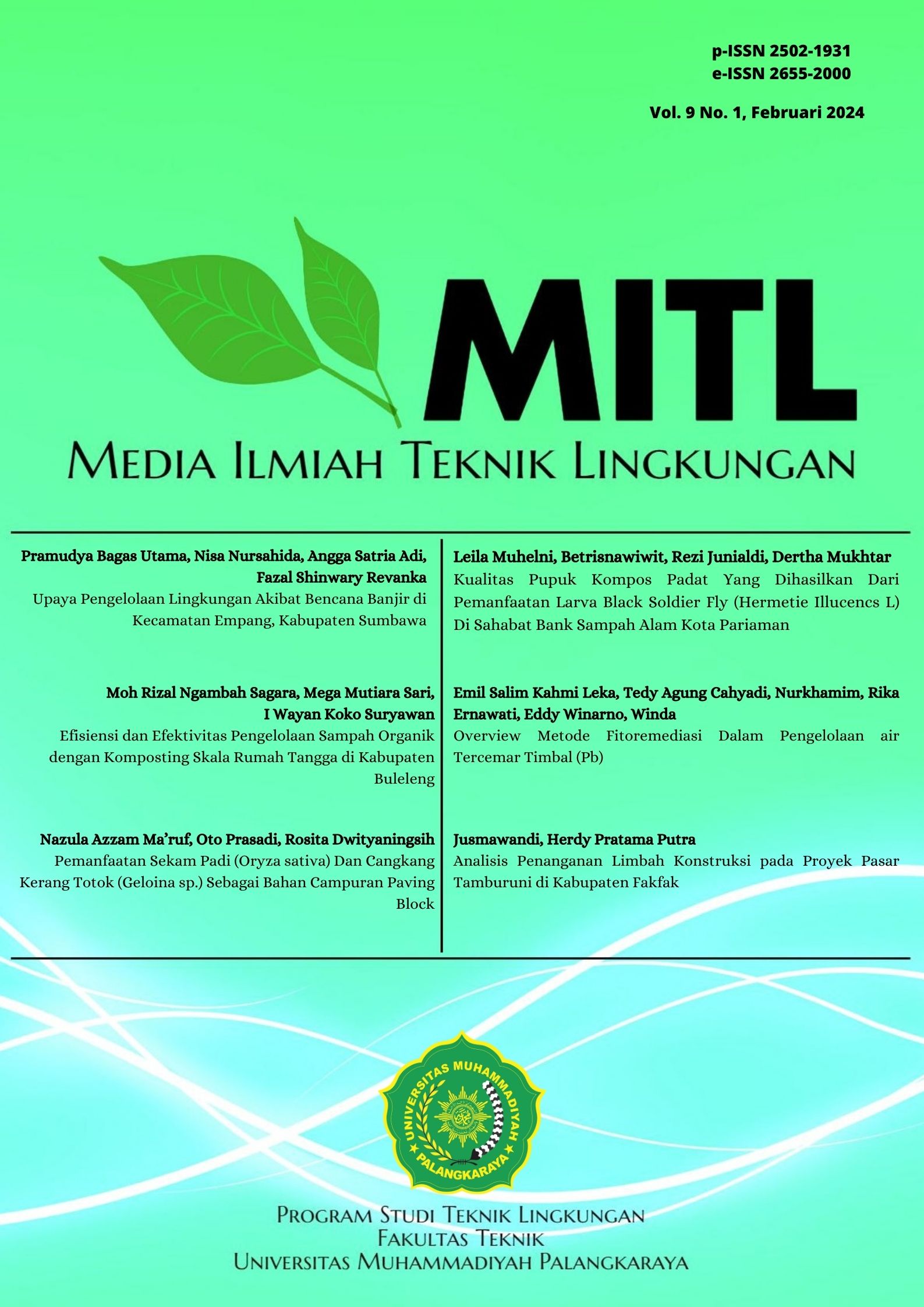Overview Metode Fitoremediasi Dalam Pengelolaan air Tercemar Timbal (Pb) Overview of Phytoremediation Methods in Management of Lead (Pb) Polluted Water
Main Article Content
Abstract
Wastewater originating from industry varies greatly depending on the type of industry. Industrial wastewater usually contains many toxic and dangerous chemical compounds (B3) and contains heavy metals. Heavy metals are pollutants that have dangerous effects because they cannot be broken down biologically and stable. Heavy metal elements can be distributed on the earth's surface in water, soil and air. Heavy metal waste pollution containing lead (Pb) is a problem for current environmental conditions. Heavy metals are found in almost all types of industrial waste. The increasing number of industries will cause increased pollution of water sources originating from industrial waste. . Therefore, effective and efficient methods are needed to manage lead-contaminated water. Methods that are easy to apply, low cost and environmentally friendly are highly desirable for managing lead-contaminated water so that the concept of good mining practice can be applied to sustainable development. The most efficient and effective method applied for mining waste management is the phytoremediation method. The results of the research state that several plants have a significant and efficient effect in helping the absorption of the metal lead (Pb) contained in water. Great Duckweed (Spirodela Polyrhiza) and Water Hyacinth (Eichhornia crassipes) are plants that are suitable for implementing phytoremediation methods in managing water contaminated with lead (Pb).
Downloads
Article Details

This work is licensed under a Creative Commons Attribution-ShareAlike 4.0 International License.
All rights reserved. This publication may be reproduced, stored in a retrieval system, or transmitted in any form or by any means, electronic, mechanical, photocopying, recording.
References
Y. Du, Q. Wu, D. Kong, Y. Shi, X. Huang, D. Luo, Z. Chen, T. Xiao and J. Y. S. Leung, "Accumulation and Translocation of Heavy Metals in Water Hyacinth: Maximising the Use of Green Resources to Remediate Sites Impacted by E-Waste Recycling Activities," Ecological Indicators, vol. 115, 2020. DOI: 10.1016/j.ecolind.2020.106384
J. A. Romero-Hernández, A. Amaya-Chávez, P. Balderas-Hernández, G. Roa-Morales, N. González-Rivas and M. A. Balderas-Plata , "Tolerance and Hyperaccumulation of A Mixture of Heavy Metals (Cu, Pb, Hg, and Zn) by four aquatic macrophytes," International Journal of Phytoremediation, vol. 19, no. 3, pp. 239-245, 2017. DOI: 10.1080/15226514.2016.1243707
L. Xu, F. Zhang, M. Tang, Y. Wang, J. Dong, J. Ying, Y. Chen, B. Hu, C. Li and L. Liu, "Melatonin Confers Cadmium Tolerance by Modulating Critical Heavy Metal Chelators and Transporters in Radish Plants," Journal of Pineal Research, 2020. DOI: 10.1111/jpi.12659
L. Chen, N. Li, Z. Wen, L. Zhang, Q. Chen, L. Chen, P. Si, J. Feng, Y. Li, J. Lou and L. Ci, "Graphene Oxide Based Membrane Intercalated by Nanoparticles for High Performance Nanofiltration Application," Chemical Engineering Journal, vol. 347, pp. 12-18, 2018. DOI: 10.1016/j.cej.2018.04.069
V. Kumar, Y.-S. Lee, J.-w. Shin, K.-H. Kim, D. Kukkar and Y. F. Tsang, "Potential Applications of Graphene-based Nanomaterials as Adsorbent for Removal of Volatile Organic Compounds," Environment International, vol. 135, 2020. DOI: 10.1016/j.envint.2019.105356
K. A. Alaboudi, B. Ahmed and G. Brodie, "Phytoremediation of Pb and Cd Contaminated Soils by Using Sunflower (Helianthus annuus) Plant," Annals of Agricultural Sciences, vol. 63, no. 1, pp. 123-127, 2018. DOI: 10.1016/j.aoas.2018.05.007
A. Shen, R. Qian, T. Liu, Q. Liu, B. Liu and Z. Wu, "Vaccines Developed for Cancer Immunotherapy," Immunization - Vaccine Adjuvant Delivery System and Strategies, 2018.
P. B. Tchounwou, C. G. Yedjou, A. K. Patlolla and D. J. Sutton, "Heavy Metals Toxicity and the Environment," Molecular, Clinical and Environmental Toxicology, vol. 101, pp. 133-164, 2012. URL: https://doi.org/10.1007%2F978-3-7643-8340-4_6
K. K. Yadav, N. Gupta, A. Kumar, L. M. Reece, N. Singh, S. Rezania and S. A. Khan, "Mechanistic Understanding and Holistic Approach of Phytoremediation: A Review on Application and Future Prospects," Ecological Engineering, vol. 120, pp. 274-298, 2018. DOI: 10.1016/j.ecoleng.2018.05.039
M. N. V. Prasad, A state-of-the-art report on bioremediation, its applications to contaminated sites in India, New Delhi: Ministry of Environment and Forests, 2011.
I. Raskin, R. D. Smith and D. E. Salt, "Phytoremediation of Metals: Using Plants to Remove Pollutants from the Environment," Current Opinion in Biotechnology, vol. 8, no. 2, pp. 221-226, 1997. URL: https://doi.org/10.1016/S0958-1669(97)80106-1
A. P. Marques, A. O. Rangel and P. M. Castro, Remediasi Logam Berat Tanah yang Terkontaminasi: Fitoremediasi sebagai Teknologi Pembersihan yang Berpotensi Menjanjikan, 2009.
